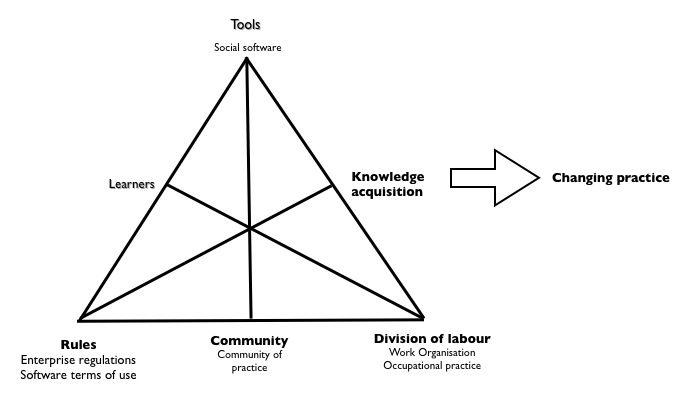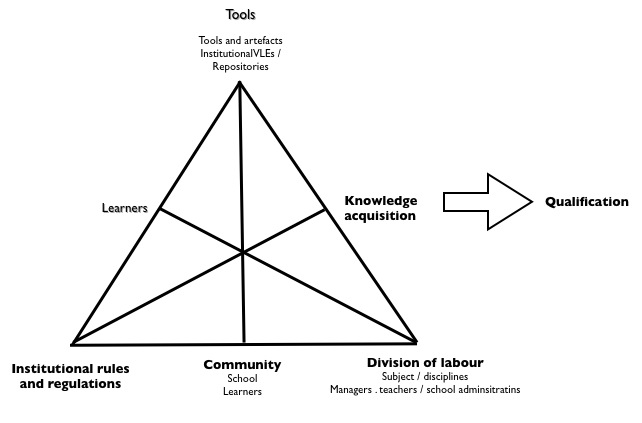Vygotsky, Activity Theory and the use of tools for formal and informal learning
In general I don’t like Christmas. Difficult travel, rampant consumerism, enforced jollity and all that kind of thing. But there is one thing I like about it and that is the peace away form day to day meetings to try and think and write a little. In this case I have an overdue short paper to deliver for the MatureIP project looking at teh work of Vygotsky and what we can learn from his work for knowledge maturing processes and for Personal Learning Environments.
Needless to say, I have not finished it yet and the more I read the more confused I seem to get.
The approach Vygotsky took to cognitive development is sociocultural, working on the assumption that ‘action is mediated and cannot be separated from the milieu in which it is carried out’ (Wertsch, 1991:18).Vygotsky considered that “higher mental functions are, by definition, culturally mediated.” Social processes give rise to individual processes and both are essentially mediated by artefacts.
Furthermore Vygotsky held that “environment cannot be regarded as a static entity and one which is peripheral in relation co development, but must be seen as changeable and dynamic.” The social cultural approach to learning has been extended through Activity Theory and I find that interesting in the context of comparing formal education and the use of tools compared to informal learning in social networks. Within an activity system tools or instruments – including technologies – are considered to be mediating elements.
First lets look at formal education. Formal education systems are heavily rule bound, with rule determining both the contents and usually the process of learning. The divisions of labour are strongly defined, especially with regard to the roles of managers and teachers within teh system. the community is that of the institution, which once more is heavily prescriptive regarding tools and objects with outcomes frequently being seen as formal acquisition of qualifications. In this subject – or learner – situation the selection of the tools which mediate the learning. Indeed in this activity system the selection of tools is intended more to preserve the rules and the division of labour and to contain the outcomes, than it is to support learning per se.

Then lets compare that with the use of social software for learning in the workplace. Firstly the division of labour is very different and more likely to be influenced by work place divisions than that of teachers. In this respect if the object is knowledge acquisition the outcomes may well be bounded by work processes, for instance through the need to solve a problem or through the introduction of new technologies or innovation in the workplace. The division of labour still remains important to the activity, especially the object, in permitting or restraining the time and the access of the subject to the tools they need to undertake the activity. However it is important to note that Vykotsky saw learning as taking place in Zones of Proximal development and to be influenced by the interventions of a Significant Other Person. This could be a teacher, a trainer, a peer. However this process is once more mediated by instruments or tools thus meaning that significant person or persons could be supporting learning through a forum or through a Personal Learning Network.
Once more the tools will mediate the activity of learning. But here the prescription may be less in that the community itself will influence the tools and may be a broader community of learners or a community of practice, recommending tools based on a collective experience. However, rules may still apply especially through the Terms and Conditions of Service and use of any particular social software service. In the context of the tools, Vygotsky considered that all artefacts are culturally, historically and institutionally situated. “In a sense, then, there is no way not to be socioculturally situated when carrying out an action. Conversely there is no tool that is adequate to all tasks, and there is no universally appropriate form of cultural mediation. Even language, the ‘tool of tools’ is no exception to this rule”. (Cole and Wertsch).
In terms of informal learning and work based learning, the tools are less likely to be culturally bound to the institution of the school. Thus more often we may see the appropriation of cultural tools or artefacts used in wider society and repurposed for learning, than the use of explicitly ‘educational software’. But over a period of time, as the practice of the use of such tools for learning becomes culturally embedded within society, it may start to influence the selection of tools and instruments for learning within institutions framed through the rules and division of labour of the education systems.
Sorry if all this is not too clear. But I would very much welcome any feedback 🙂


In Folksonomological Reification (http://www.lulu.com/items/volume_64/6043000/6043166/2/print/6043166.pdf) I felt it was important to modify the Activity Theory ‘triangle’ for use with social tools relating to learning practice. The reason being that the revised version seems to me to emphasise the importance of the links between community and tools. Additionally, it can be argued that with social media (Web2.0) style tools, the tool being used is really the information which has been contributed by the community rather than the underlying ‘code’ which quickly reaches the status of infrastructure (http://brains.parslow.net/network-as-tool). With this view, the tool itself is in a continual flux, changing and adapting to the environment through use (which is what suggested using Activity Theory in the first place).
I think it is also useful to consider the roles individuals are playing when interacting using these tools to learn or either implicitly or explicitly support someone else’s learning (http://brains.parslow.net/role_taxonomy). To my mind, the role someone is in for a particular interaction probably has more impact than the actual tool itself. Tool selection is largely a matter of personal preferences, for client-side tools, and a matter of pragmatism in finding and connecting to others in terms of infrastructure based tools (e.g. Twitter is a useful medium for canvassing a broad church of people, but you can use many different clients to access that network). Interaction between the channels of communication (bridges between email, web pages, twitter, jabber etc.) allow a much wider range of choices. Of course, these are often limited by institutions, but as you suggest it is likely that, over time, the institutions will have to modify their rules and norms either due to the realisation that control is not in their best interests or because of direct pressure from their learners.
Graham –
Thanks for this post – you’re wading into some deep water : )
I’ve been working on a project in the direction of social /informal learning for quite some time and I’m still trying to get my head around the theory.
Trying to build things has forced some simplicity on us, but these questions are still fascinating to me. The implementation of this starts easy enough – with “learner centered tools” – an aggregation model shown by Facebook (if you think of their various features as sep. tools) Friendfeed, drupal, Bpress, and the new version of Moodle all show some strong trending this direction.
Where I’m slightly confused with Vygotsky is in the attachment of tool to context and task. In the social tools sphere, RSS and APIs break (or constantly repurpose) context.
The individual uses Linkedin to build their reputation and passively job hunt. The enterprise, now with access to the Linkedin API, can use that same tool for Human Resource mapping. Some of this mapping can be used for the creation of Proximal Development Zones (Networks) for the employees – “Employees like you left for 3 years, worked at a non-profit and came back – talk to Sally, Jim and Mark about their experiences”
Our focus has shifted to the work around creating Proximal Zones (or learner networks) – we don’t care what publishing tool is used to express the learners interest or level. Most of them come with text or tags and semantic analysis is becoming increasingly realistic.
In short – we’re betting that adoption rates for various tools will vary for many reasons, but that Zones of development – wrapped around both people and their content – will be paramount.
(Sorry if this is less clear than your post : )
Have sent quite a lengthy comment to Jo Turner on her blog on Vygotsky but I don’t think it has appeared. Might be useful to put both blogs and comments together on the site.
As you well know, I have never been a huge Vyg. fan. I thought his work was interesting and important – but seriously flawed! And I really don’t think he was as apocryphal as he seems to be becoming. You know my predilection for rooting around past thinkers looking for clues and ideas for explaining the present – well I think there are lots of others with more to say and which are not based on introspectionism.
I am still a bit unclear on terminology. What exactly is the definition of a mediating tool and how does it differ inherently from an artefact? Help please.